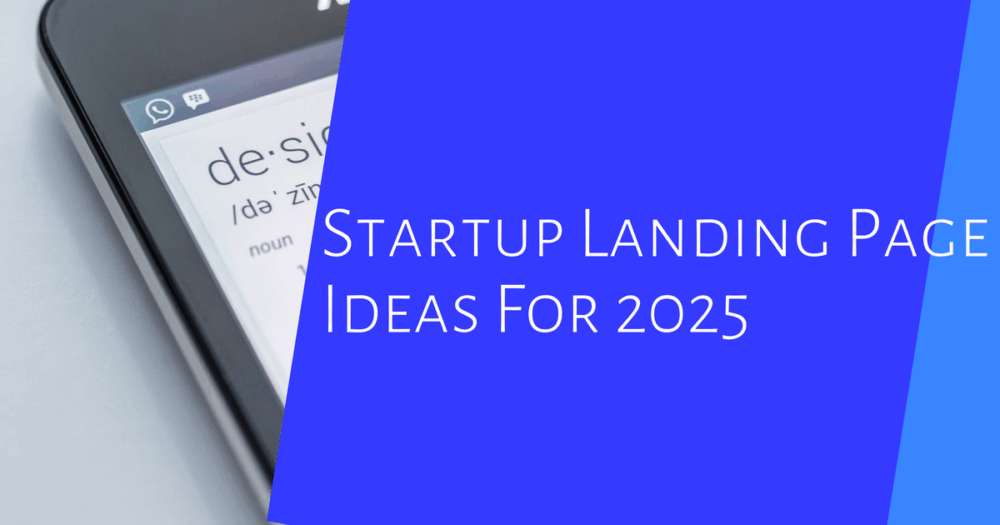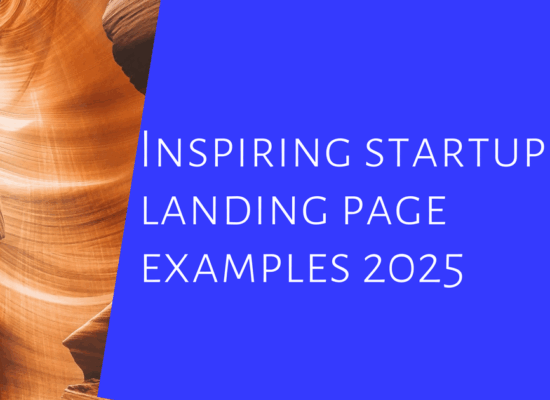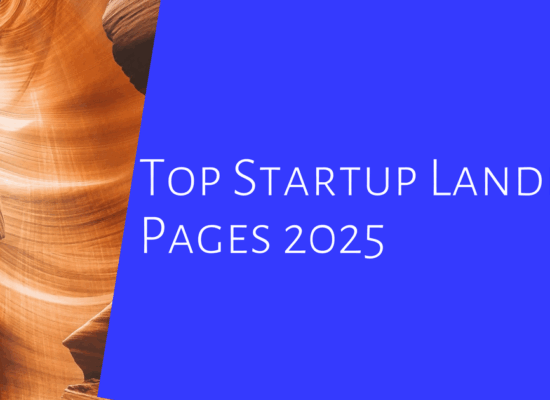Table of Contents
- 1. Coinbase: Building Trust with Data and Security
- 2. BuzzSumo: Try Before You Buy with Interactive Demos
- 3. Bankjoy: Minimal Text and Visual Trust Builders
- 4. Fundera: Simple Forms for Quick Lead Qualification
- 5. Final: Video Engagement and Vibrant User Interface
- 6. BlockScore: Explaining Complex Services with Icons
- 7. Checkr: Interactive Product Previews for Clarity
- 8. Flynn: Minimalist Design for Developer Focus
- 9. CodeCombat: Gamified Learning with User Reviews
- 10. TrueVault: Modern Visuals for High-Tech Security
- 11. Tectonic: Video-Driven Product Education
- 12. Bitnami: Practical Tech Design with Instant Access
- 13. Strikingly: Demonstrating Capabilities with Interactive Signup
- 14. Svbtle: Minimalism Supporting Content Focus
- 15. Rackspace: Organized Sitemap-Style Navigation
- 16. Ahrefs: Data-Rich Features and Social Proof
- 17. FormAssembly: Brand Association to Build Trust
- 18. Sharethis: Simple Modular Feature Presentation
- 19. Adobe Express: Creative UI for Storytelling
- 20. Contently: Visual Data Messaging with Lead Magnets
- 21. Curata: Video Storytelling Combined with Free Resources
- 22. MailChimp: Clean Design with Clear Pricing
- 23. Benchmark: Engaging Interactive Pricing and CTAs
- 24. CodeSignal: Vibrant Design for Developer Engagement
- 25. Thumbtack: User Reviews and Mobile Lead Capture
This report highlights 25 startup landing pages that set a good example for design in 2025. These pages show how simplicity, clear calls to action, and trust-building elements can work together well. Some sites like Coinbase focus on security through data visuals, while others like BuzzSumo let users try the product right away. Video use and interactive features also stand out to keep visitors engaged, as seen with Final and Checkr. Across all examples, making things easy to understand and navigate is key. The blend of visual appeal with practical user experience helps startups build credibility and convert visitors effectively.
1. Coinbase: Building Trust with Data and Security
Coinbase’s landing page stands out by putting trust and transparency front and center, crucial for a cryptocurrency wallet and trading platform. It prominently displays analytical data, including interactive JavaScript charts that track Bitcoin circulation trends, which not only engage visitors visually but also establish credibility through clear, data-driven insights. Security features are highlighted clearly, addressing common user concerns about the safety of their assets. The design leans on clean typography and a professional layout that balances technical details with simple explanations, making it accessible to both beginners and experienced users. The color palette and structured layout reinforce a sense of reliability and safety, while straightforward calls to action guide users confidently toward creating an account or learning more. Overall, Coinbase’s approach combines clarity, professionalism, and education, building user confidence through a transparent, data-focused presentation.
2. BuzzSumo: Try Before You Buy with Interactive Demos
BuzzSumo’s landing page stands out by letting users dive straight into the product with an interactive demo on the homepage. Operating in content performance and influencer analytics, BuzzSumo uses a freemium model that lowers the barrier to entry by encouraging hands-on experience before asking for a sign-up. This demo preview is designed with minimal distractions, keeping the focus on key product features and benefits through clear explanations and real-time data samples. The layout supports smooth navigation between the demo and sign-up forms, guiding users naturally from curiosity to action. By offering value upfront and showcasing the app’s capabilities through live examples, BuzzSumo efficiently captures leads while building user confidence, making it a smart approach for SaaS startups aiming to boost conversions with transparency and engagement.
3. Bankjoy: Minimal Text and Visual Trust Builders
Bankjoy’s landing page stands out by focusing on mobile banking solutions tailored specifically for credit unions. It opens with a brief, clear introduction that states the business name, what it offers, and a straightforward call to action inviting visitors to schedule a preview. The page uses multiple app screenshots to showcase the platform’s interface and usability, letting visuals tell much of the story. This minimal use of text helps reduce cognitive load, keeping visitors’ attention on the product itself. Whitespace is used skillfully throughout the layout to avoid clutter and maintain focus on key elements. Trust is fostered through a clear presentation of product benefits alongside easy engagement options like a simple email form in the footer, making it effortless for users to sign up for a demo. The color palette and typography strike a balance between professionalism and approachability, supporting a sense of reliability without feeling cold. Visual snapshots demonstrate real use cases, which helps reassure potential users about the platform’s value. Overall, the design encourages exploration and interaction without overwhelming visitors, making it a solid example of how minimal text combined with strong visuals can build trust and drive conversions.
4. Fundera: Simple Forms for Quick Lead Qualification
Fundera’s landing page focuses on an efficient, no-nonsense approach to lead qualification for small business loans. It uses a simple signup form that collects just the essential details: loan amount, business age, credit score, and loan purpose. This straightforward form design removes distractions, guiding visitors directly to completing the inputs without confusion. The fields are logically ordered to encourage quick responses, reflecting Fundera’s promise of fast and affordable funding. Clear, concise copy explains eligibility and the process in plain language, building trust and a sense of urgency. The call to action is prominent and direct, making it easy for users to take the next step. Overall, Fundera’s landing page is a strong example of how transparency and simplicity in form-driven design can efficiently qualify leads and improve conversion rates in the competitive business loan space.
| Form Field | Purpose | Design Insight |
|---|---|---|
| Loan Amount | Collect amount of loan requested | Simple input to encourage fast completion |
| Business Age | Determine eligibility based on how long business exists | Captures relevant qualification data |
| Credit Score | Assess borrower’s creditworthiness | Important for loan qualification |
| Loan Purpose | Understand reason for loan | Helps personalize loan offers |
5. Final: Video Engagement and Vibrant User Interface
The Final landing page smartly uses a video right at the start to explain its personal finance and banking management platform benefits. This approach quickly grabs visitor attention and cuts down the need for heavy reading, making the product approachable from the first second. Alongside the video, a large input form invites users to subscribe for early access, which helps capture leads efficiently. The sticky navigation bar ensures smooth browsing, letting users jump to key info without hassle. Visually, the page uses colorful, modern aesthetics that give the brand a fresh and dynamic personality. Screenshots highlight app features in vibrant detail, balancing multimedia and clear call-to-actions to guide users seamlessly through the experience. Subtle animations and motion effects are applied to keep engagement up without causing distractions. Overall, the layout supports quick understanding of the product’s value and encourages visitors to sign up early, blending interactive content with straightforward usability.
6. BlockScore: Explaining Complex Services with Icons
BlockScore’s landing pages excel at making a technical product accessible through thoughtful design. Specializing in real-time fraud verification for both individuals and businesses, BlockScore separates these offerings into dedicated pages, ensuring clear and relevant information for each audience. The standout feature is its scrolling list of product features, where icons play a crucial role in visually breaking down complex concepts. Instead of overwhelming visitors with dense text, these icons quickly communicate key benefits, helping users grasp what the service does at a glance. The lively UI elements throughout the pages keep the content approachable without sacrificing professionalism, while well-organized typography and spacing improve readability of detailed explanations. Logical segmentation of information guides visitors smoothly through the product’s capabilities. Additionally, developer documentation is easily accessible, supporting seamless integration for technical users. Clear calls to action invite visitors to start trials or request demos, reinforcing the goal of conversion. Overall, BlockScore’s design balances educating visitors on specialized fraud verification services with a user-friendly experience that simplifies complexity through smart visual cues.
- Specializes in real-time fraud verification for users and businesses
- Dedicated product pages separate personal and business verification offerings
- Scrolling feature list uses icons to simplify complex concepts visually
- Developer documentation is accessible, supporting integration
- Design uses lively UI elements to keep technical content approachable
- Icons help users quickly grasp key features and benefits
- Pages segment information logically for easier navigation
- Typography and spacing improve readability of detailed content
- Calls to action guide users toward product trials or demos
- Overall design educates visitors clearly on specialized services
7. Checkr: Interactive Product Previews for Clarity
Checkr’s landing page excels by using an interactive product preview that immediately shows users how its background check service integrates into hiring workflows. The large clickable GIF demonstrates the interface in action, making it easy to grasp key features without reading through dense text. Clear outlines of screening categories reduce confusion and highlight the product’s capabilities, while visuals help remove ambiguity around what the service offers. The layout prioritizes essential information for quick understanding, balancing detail with simplicity to build user confidence. Additionally, the comprehensive footer acts as an information hub with FAQs and helpful resources, supporting user education and lowering friction in decision making. Call to action buttons encourage visitors to explore features further or request demos, nudging them toward engagement. Overall, Checkr’s design approach combines clarity, interactivity, and support to make complex background checks feel accessible and trustworthy for potential customers.
8. Flynn: Minimalist Design for Developer Focus
Flynn’s landing page stands out with its minimalist design tailored specifically for developers. As an open-source software deployment and management tool, it embraces simplicity through a clean grid layout set against a white background, which creates a distraction-free environment. Large headings and well-aligned text not only improve readability but also help users scan the page quickly, respecting the limited time developers often have. Clear call-to-action buttons inviting visitors to start trials or subscribe are easy to find, making the conversion process straightforward. The subtle color scheme maintains a professional and clean feel without overwhelming the viewer, while ample whitespace and careful typography choices support content clarity. Navigation is kept simple, focusing on core features and benefits to efficiently communicate essential information. Overall, Flynn’s landing page exemplifies how a minimalist, no-frills approach can effectively cater to a technical audience by promoting efficiency, directness, and clarity.
9. CodeCombat: Gamified Learning with User Reviews
CodeCombat’s landing page effectively communicates the advantages of learning programming through a gamified browser game, appealing mainly to children and educators. The design strikes a balance between education and entertainment, using gaming-themed visuals and interface elements that evoke fun and engagement. Clear messaging highlights how gameplay supports real learning outcomes, making it easy for visitors to understand the platform’s value. User reviews and testimonials provide social proof, building trust by showcasing positive experiences from both learners and teachers. Calls to action are prominent and inviting, encouraging sign-ups and exploration of available courses. The overall design creates an approachable and motivating atmosphere that resonates with younger audiences and educators looking for interactive teaching tools.
10. TrueVault: Modern Visuals for High-Tech Security
TrueVault’s landing page stands out with a sleek, futuristic design that perfectly matches its role as a database security platform for healthcare and other high-demand sectors. The animated background video immediately sets a tech-forward tone without distracting from the core message. As users scroll, a slider reveals key team members and layered service offerings, fostering transparency and trust, important for a company dealing with sensitive data. Large counters highlight the volume of records managed, subtly reinforcing TrueVault’s reliability and scale. The layout supports a clear narrative around data security and management, using well-chosen typography and a color palette that conveys professionalism and high-tech sophistication. Strategic calls to action are placed thoughtfully to guide engagement, while subtle animations keep users interested without overwhelming them. Overall, the design projects confidence in both security and operational capacity, making it a strong example for startups aiming to communicate trust and innovation through their landing pages.
11. Tectonic: Video-Driven Product Education
Tectonic’s landing page stands out by using video content as the core method to explain its secure container transportation solutions. Instead of overwhelming visitors with dense text, it relies on clear, focused videos that demonstrate product performance and real-world applications, helping technical buyers grasp complex concepts quickly. The site breaks down features into separate landing pages, making navigation straightforward and allowing users to explore individual benefits without distraction. This approach combines visual storytelling with detailed technical information, building confidence in decision-makers who need thorough education before committing. Videos showcase reliability and use cases, reducing hesitation by answering questions that might otherwise require direct contact. The design minimizes text overload and highlights clear calls to action, creating an efficient path from curiosity to conversion while catering specifically to the needs of a technical audience.
12. Bitnami: Practical Tech Design with Instant Access
Bitnami’s landing page stands out by focusing on a practical, no-nonsense design that caters directly to tech-savvy users. The use of icon-based navigation quickly communicates popular applications like WordPress and MediaWiki, making it easy for developers to identify and select the software they need. One of the core strengths is the ability to launch these applications instantly, either in the cloud or through local installation, which simplifies what is traditionally a complex setup process. The interface balances technical details with clarity, avoiding unnecessary clutter while still providing enough information about deployment options and supported platforms. Including customer reviews adds a layer of credibility for developers who rely on peer feedback. The design encourages immediate interaction by highlighting one-click deployment, inviting users to try the product right away. This approach not only builds trust but also engages the developer audience effectively, making Bitnami’s landing page a strong example of how to simplify advanced technology with clear, practical UI elements.
13. Strikingly: Demonstrating Capabilities with Interactive Signup
Strikingly’s landing page stands out by putting its product capabilities front and center, encouraging users to engage right away. The interactive signup form simplifies registration with OAuth options, allowing visitors to quickly use social logins like Google or Facebook, which reduces friction and speeds up onboarding. The page breaks down the website building process into three clear, simple steps, making it approachable for both beginners and professionals. To boost confidence, Strikingly showcases real design examples created with the platform, using clean visuals that inspire users and highlight the quality they can achieve. The layout remains uncluttered, directing attention smoothly toward the signup call to action while balancing feature explanations with motivation to start immediately. This approach effectively promotes a quick start, reducing hesitation and making it easy for users to jump in and create their own websites without feeling overwhelmed.
14. Svbtle: Minimalism Supporting Content Focus
Svbtle embraces minimalism to sharpen the focus on writing and content creation, stripping away distractions that often clutter blogging platforms. Its clean typography paired with generous white space creates an uncluttered canvas that encourages long-form, thoughtful posts. The design appeals particularly to developers and creative users who value clarity and simplicity, as emphasized on its About page. By offering minimal navigation and avoiding unnecessary features, Svbtle supports a straightforward blogging experience where ease of publishing takes priority. This balance of aesthetic calm and functional simplicity meets the needs of users seeking distraction-free writing environments, making it a standout example of how minimal design can enhance content focus.
15. Rackspace: Organized Sitemap-Style Navigation
Rackspace’s landing page stands out with its clean, sitemap-style organization that lists key use cases like eCommerce, email, and security right on the homepage. Instead of overwhelming visitors with a flood of products, it groups complex cloud and hosting services into clearly labeled, clickable sections. This solution-focused navigation helps business users quickly find what fits their needs without digging through clutter. The modular layout keeps the page tidy and easy to scan, making decision-making smoother for visitors. Plus, an accessible contact form invites users to connect directly with experts, turning navigation into lead capture. Overall, Rackspace presents complicated offerings in a straightforward, user-friendly way that supports tailored hosting solutions and improves user engagement.
16. Ahrefs: Data-Rich Features and Social Proof
Ahrefs’ landing page stands out by combining a data-driven approach with clean, approachable design. It uses icon-based navigation to highlight key SEO tools like backlink analysis and competitor monitoring, making it easy for users to grasp the platform’s capabilities at a glance. Visual previews demonstrate how these tools work, reinforcing understanding without overwhelming the visitor. Large data points, such as the size of Ahrefs’ database and keyword metrics, are prominently displayed to validate the product’s strength and market position. Social proof is woven in through expert industry reviews, which add credibility and help build trust. By organizing detailed feature information clearly and avoiding clutter, the page balances technical complexity with user-friendly presentation. This thoughtful design supports users in making informed decisions while driving conversions through clear benefits and trusted endorsements.
17. FormAssembly: Brand Association to Build Trust
FormAssembly’s landing page effectively balances detailed product information with user-friendly design to build trust among enterprise users. It features a compact container that combines essential product highlights with a prominent Twitter customer review, using social proof to boost credibility. By listing major clients such as PayPal and Amazon, the page leverages recognizable brand associations that reinforce reliability and professionalism. The design carefully manages information density, ensuring readability while emphasizing key features like security and design-friendly form building, critical for users handling sensitive data. Navigation is simplified with a well-organized footer that offers helpful links and support resources, encouraging user confidence before signup. Overall, this landing page targets professional users who need secure, trustworthy form solutions by blending brand trust, social proof, and clear access to important information.
18. Sharethis: Simple Modular Feature Presentation
Sharethis excels by dedicating individual landing pages to each of its social sharing tools, making it easy for users to focus on one feature at a time without being overwhelmed. The pages show clear examples of button placements and styling options, using clean layouts and minimal text supported by visuals to communicate the benefits clearly. This modular approach highlights each product component simply, allowing website owners to understand and compare specific tools efficiently. The design emphasizes user control over social sharing setups, helping users pick and integrate the right tools with ease. Sharethis’ scalable feature adoption model supports growth without clutter, maintaining simplicity while guiding visitors through their social sharing options.
19. Adobe Express: Creative UI for Storytelling
Adobe Express stands out as a platform designed to simplify animated video creation, making it accessible for creators of all skill levels. Its user interface strikes a balance between elegance and intuitiveness, allowing users to record voice-overs that sync seamlessly with automatic animations. This feature reduces the complexity often associated with video editing while retaining creative control. The landing page highlights a vast library of iconic images, empowering storytellers to enrich their videos visually without searching elsewhere. Showcasing a variety of video examples and creative use cases, Adobe Express inspires users by demonstrating the versatility of its multimedia tools for different content types, from marketing clips to personal stories. The design encourages experimentation through interactive elements that invite users to explore and customize their projects easily. By emphasizing ease of use alongside powerful features, Adobe Express’s landing page effectively communicates how its platform supports content creators in crafting rich, animated stories with confidence.
20. Contently: Visual Data Messaging with Lead Magnets
Contently’s landing page stands out by showcasing real-time analytics previews that clearly demonstrate the platform’s capabilities, making complex data easy to grasp through large, impactful visuals. It targets content marketing professionals who want measurable results by balancing informative content with straightforward calls to action. The page uses free content marketing tips as a lead magnet, effectively capturing leads while nurturing potential customers with educational resources. User reviews add social proof, building confidence in the platform’s value. The clean layout supports easy comprehension of data-driven messaging, highlighting Contently’s strengths through expert endorsements and transparent presentation of its benefits.
21. Curata: Video Storytelling Combined with Free Resources
Curata’s landing page stands out by starting with a concise 2-minute video that clearly explains the platform’s core benefits and how it supports content marketers. Using video as the main storytelling tool helps engage visitors quickly and simplifies complex marketing concepts that might otherwise feel overwhelming. The design remains clean and professional, keeping the focus on the video and key messages without unnecessary distractions. To build trust, Curata prominently displays logos of well-known customers, leveraging social proof effectively. Beyond storytelling, the page offers valuable free resources related to content marketing, encouraging visitors to download or access them in exchange for lead information. This balance of visual engagement and educational content positions Curata not just as a tool, but as a helpful partner in marketers’ productivity. Clear calls to action guide users toward demos or resource downloads, while straightforward navigation ensures ease of use despite the rich media elements. Overall, Curata’s approach highlights practical benefits and builds credibility through a smooth blend of video, social proof, and free educational assets.
22. MailChimp: Clean Design with Clear Pricing
MailChimp’s landing page stands out with a clean and bold design that immediately draws attention to its email marketing platform. The homepage features a clear screenshot of the interface, giving visitors a direct visual understanding of the product. A prominent sign-up call to action encourages users to engage without delay, reducing friction in the conversion process. The pricing pages are thoughtfully structured, presenting scalable options based on subscriber counts, which helps users easily find a plan that fits their needs. MailChimp emphasizes the benefits of its free plan, lowering barriers for new users to try the service. Its design relies heavily on whitespace to separate content and improve readability, avoiding clutter that could overwhelm visitors. Navigation is simple and intuitive, guiding users smoothly between features, pricing details, and support resources. Consistent branding with a friendly yet professional color palette reinforces trust and approachability. Concise copy accompanies each pricing tier, clearly explaining what features are included, which helps users make informed decisions quickly. Finally, the site is fully mobile responsive, ensuring accessibility and a seamless experience across all devices, reflecting modern user expectations.
23. Benchmark: Engaging Interactive Pricing and CTAs
Benchmark’s landing page stands out by combining interactive elements with clear calls to action that drive conversions effectively. The sliding navigation highlights five key features in an engaging way, inviting users to explore without feeling overwhelmed. A prominent call to action for the free plan stays visible throughout the browsing experience, encouraging sign-ups without interrupting the flow. One of the page’s strongest points is the interactive pricing calculator, which lets visitors estimate costs tailored to their needs, improving transparency and trust. Automated live chat support is seamlessly integrated, offering real-time assistance that helps reduce friction and answer questions instantly. The design balances bright, clean visuals with smooth transitions, keeping users interested and guiding them through clear feature explanations. This thoughtful user interface maintains simplicity while providing enough detail so visitors can make informed decisions. The layout is fully responsive, adapting smoothly to both mobile and desktop screens, ensuring a consistent experience for all users. Strategically placed CTAs capture leads effectively without feeling pushy, making Benchmark’s approach a solid example of combining interactivity with straightforward, user-friendly design.
24. CodeSignal: Vibrant Design for Developer Engagement
CodeSignal’s landing page stands out with its sleek blue-themed design that immediately connects with its tech-savvy audience. Animated hero characters add a lively touch without compromising page speed, making the site feel dynamic and modern. The large, bright red sign-up button is impossible to miss, guiding motivated developers straight to action. The page highlights gamified programming challenges that turn skill assessments into engaging experiences, appealing to developers looking to sharpen and showcase their coding abilities. Navigation is kept simple and direct, helping users quickly explore key features, challenge types, and sign-up options. Brief, clear descriptions explain the benefits of assessments for both candidates and employers, reinforcing the platform’s value. Additionally, the mobile-friendly design ensures a smooth experience across devices, making CodeSignal’s landing page a strong example of balancing professionalism with playful energy to engage a developer audience effectively.
25. Thumbtack: User Reviews and Mobile Lead Capture
Thumbtack’s landing page stands out by simplifying the hiring process into three clear steps, making it easy for users to find and hire local professionals without confusion. Prominently displayed customer reviews build trust and validate the quality of services offered, combining social proof with a clean, user-friendly design. The site organizes professional listings with state-wise links, allowing visitors to quickly find services in their area. A smart mobile acquisition strategy is integrated right into the footer, where a simple phone input form lets users request app download links instantly, encouraging mobile engagement. Brief service descriptions clarify what users can expect, while clear calls to action guide visitors smoothly from browsing to hiring or requesting quotes. Overall, the design balances visual appeal with functional simplicity, ensuring the landing page not only looks good but works effectively to convert visitors into leads and customers.
Frequently Asked Questions
1. What key design elements should I focus on when creating a startup landing page for 2025?
In 2025, focus on a clean, user-friendly layout with clear calls to action, fast loading times, mobile responsiveness, and engaging visuals. Use modern typography and consider interactive elements that enhance user experience without slowing down the page.
2. How can I balance creativity and functionality in a startup landing page design?
Balancing creativity and functionality means using eye-catching visuals and unique layouts while ensuring the page is easy to navigate and understand. Avoid clutter, keep messages clear, and prioritize user goals like signing up or learning more about your product.
3. What role do startup landing pages play in building user trust and credibility?
Landing pages build trust by showcasing clear value propositions, including social proof like testimonials or user reviews, and maintaining professional, consistent branding. Transparent communication and easy contact options also help visitors feel confident in your startup.
4. How can I use storytelling techniques effectively on a startup landing page to engage visitors?
Use concise, relatable copy that highlights the problem your startup solves and the benefits it offers. Combine this with visuals or brief videos to create an emotional connection, guiding visitors through the story of why your product matters and encouraging them to take action.
5. What emerging trends in design should I consider when looking at startup landing page examples for 2025?
Consider trends like minimalism with bold color highlights, micro-animations that add subtle interactivity, dark mode options, personalized content sections, and environmental or social responsibility cues. These trends help create a modern feel and resonate with the values of today’s users.
TL;DR This blog highlights 25 standout startup landing pages to inspire your 2025 design. From Coinbase’s trust-building data and security focus to MailChimp’s clean, clear pricing, these examples show key trends like simplicity, interactive demos, video storytelling, and strong social proof. They emphasize user experience with intuitive navigation, responsive design, and lead capture forms. Whether targeting developers, marketers, or everyday users, these pages blend modern visuals with effective CTAs to boost conversions and build credibility. A solid resource for startups aiming for landing pages that look good and work well next year.




